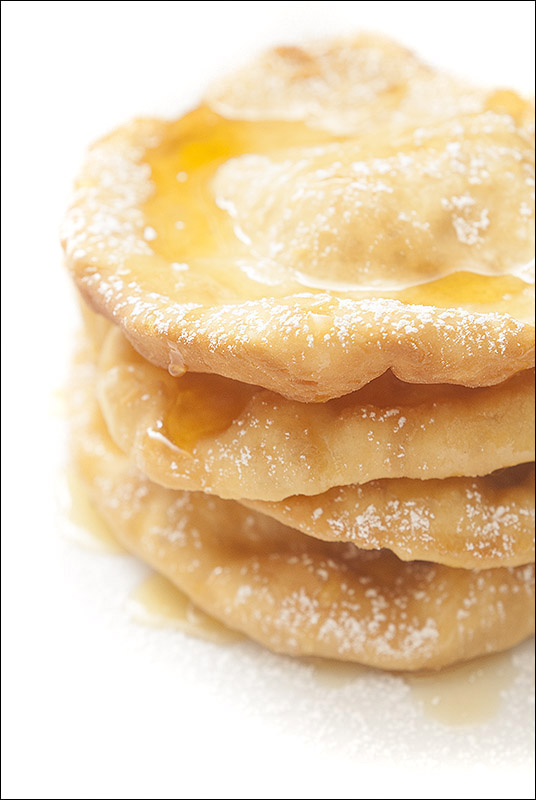 |
| Native American fry bread with agave nectar and powdered sugar. © Ryan Schierling |
Well... four, if you count the dessert version you're seeing at the top of the post which is drizzled with agave nectar and dusted with confectioners' sugar. Sugar-christened fried bread is an end-of-summer southwestern-county fair staple, but it isn't where we started. It's where we ended our meal. Let me go back to the beginning....
It turns out that fry bread is not the longstanding staple of American Indian culture it might seem from our present historical perspective. Instead, it was born of making sustenance out of nearly nothing. It was in the early 1860s that indigenous Americans were relocated to reservations in areas of the southwestern United States which did not support their traditional crops. So that they would not starve, the government provided rations of items such as flour, sugar, powdered milk, salt and lard. While fry bread may have had its beginnings in a dark time, from these staples so foreign to their kitchens were made this gloriously golden and tender fried bread.
This traditional recipe curated by the Smithsonian is the one we chose to work with. We did, however, opt to add two tablespoons of powdered milk to the warm water in the batch we made, as use of powdered milk is more common than not in the making of fry bread and we think it lends a touch of sweetness. This dough is soft, sticky and beautifully pliable. Handle it gently and don't try to work additional flour into the dough, but do use plenty of flour as you roll out the individual pieces to keep it from sticking to the surface of the board. Keep that handy-dandy kitchen thermometer close – you'll want to maintain the temperature of your frying oil (or shortening) at 350 degrees.
We would be hard-pressed to pick one of these toppings as our favorite. More importantly, we are convinced none would taste quite the same on any other style of flatbread. It is totally worth stepping outside the box for these simple variations. What you'll find below is a loose recipe format, to be sure, but the layers are listed in the order they are applied to the fry bread and each item has has the ratio of ingredients it contains. Taste each element and season with kosher salt to your liking.
 |
| (Top) Zucchini & goat cheese with caramelized onion. (Bottom left) Sweet potato & egg with arugula. (Bottom right) Hatch chile & black bean with roasted corn, cotija. © Ryan Schierling |
Zucchini & Goat Cheese
Ricotta & Goat Cheese – equal parts whole milk ricotta and chevre mixed together with a good pinch of salt (to taste).
Roasted Zucchini – sliced 3/8" thick and grilled until tender.
Caramelized Onions – white onion cut into halved rings and sauteed on low (olive oil and salt) until a golden caramel color (see here for additional tips on caramelizing onions).
Herbed Olive Oil – finely chop fresh thyme, sage and Italian parsley leaves, then warm (don't fry) on low heat with enough extra virgin olive oil to cover herbs. Spoon drizzle over top.
Roasted Garlic Sweet Potato Mash – braise sweet potato in salted water until tender. Drain off excess water (leave a little) and mix with roasted garlic plus a little brown sugar for a touch of sweetness (ratio of approximately 1 large sweet potato to 1 head of roasted garlic and 1 tablespoon brown sugar, to taste).
Sunny-side up Egg
Fresh Baby Arugula
Black Pepper
Refried Black Beans – warmed in pan with olive oil.
Roasted Corn with Red Onions – boil fresh ear(s) of corn for 5 minutes, pat dry and place on hot grill for nice char. Cut corn off of cob, dice onions and mix together in a bowl. Give a squeeze of fresh lime juice (ratio of approximately 1/2 small red onion to 2 ears corn and juice of 1/2 lime).
Roasted Hatch Chiles – hot (or mild) sliced into strips.
Cotija - crumbled.

Amazing! Do you have a recipe for fry bread?
ReplyDeletewww.atasteofkoko.com
We used the Smithsonian's recipe as a baseline. See paragraph four (above) for link and details.
Delete